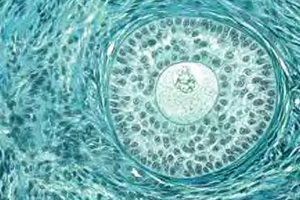MSU launches new reproductive research initiative
Cows soon may be sharing their fertility secrets to help human mothers conceive healthy babies, thanks to MSU research.
 Cows soon may be sharing their fertility secrets to help human mothers conceive healthy babies, thanks to a new initiative that combines Michigan State University research expertise in animal agriculture and human medicine.
Cows soon may be sharing their fertility secrets to help human mothers conceive healthy babies, thanks to a new initiative that combines Michigan State University research expertise in animal agriculture and human medicine.
The MSU Reproductive and Developmental Sciences Initiative will leverage ongoing collaborations among George Smith, MSU AgBioResearch animal scientist, and faculty members in animal science, human medicine, genetics and regenerative medicine who work in labs across MSU's East Lansing and Grand Rapids campuses. By formalizing its unique cross-disciplinary focus on human/animal reproduction and development, the university expects to attract top researchers and funding.
"What makes this a particularly powerful initiative is that it is faculty-driven," said J. Ian Gray, MSU vice president for research and graduate studies. “Over the next few years, the university will be investing in eight new positions across the colleges of Agriculture and Natural Resources, Human Medicine and Veterinary Medicine, and AgBioResearch to support this area of research. "We recognize that this cluster of scientific expertise could have a significant impact, not only in advancing human reproduction and development but also on animal production, which would have significant economic impact on the animal agriculture industry."
Using animal models and human clinical trials, researchers will explore all aspects of the reproductive puzzle in mammals, from genetic and environmental influences to stem cell, pharmaceutical and bioengineering solutions. The four main points of the initiative are:
- Stem cell biology/regenerative medicine, focused on reprogramming adult somatic cells to produce induced pluripotent stem cells, which share characteristics of cells in an early embryo.
- Developmental epigenetics, to better understand how environmental changes during the prenatal period and the time around and before conception lead to adult-onset diseases.
- Women's health, to further expand programs focused on understanding the biology of both benign and malignant gynecological diseases and identifying potential biomarkers for diagnosis.
- Impact of environment on reproductive function, including reproductive toxicology and tissue malignancy. The focus will be on the impact of environmental toxins on the overall reproductive health of women and livestock.
- Smith, a professor in the College of Agriculture and Natural Resources, and Asgi Fazleabas, professor and associate chairperson for research in the College of Human Medicine are the project coordinators.
Smith's research is focused on understanding fundamental mechanisms that regulate ovarian function and early embryonic development and uses dairy cattle as a biological model for reproduction in agricultural species and humans. He said the group will focus research efforts on the most pressing problems affecting fertility in humans and livestock species.
"This initiative provides a framework to recruit to MSU the very best researchers in the field to fill critical gaps necessary to address key problems related to reproduction and developmental biology, and to attract significant additional support from the National Institutes of Health and other funding agencies," Smith said.
Fazleabas, who recently was named a fellow of the American Association for the Advancement of Science, leads the $6.8 million Center for Women's Health and Reproduction Research. MSU, Spectrum Health Hospital Group and the Van Andel Institute collaborate on various projects through the center, located in Grand Rapids.
"The history of investment in reproductive and developmental sciences research at MSU has helped foster the current success of individual research programs," Fazleabas said. "This new initiative promises to dramatically improve our potential for future funding and ultimately should propel the research breakthroughs we seek."



 Print
Print Email
Email





